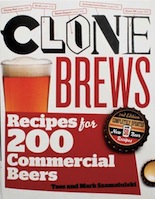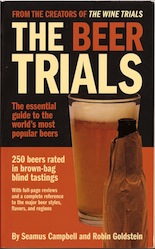Lisa Morrison
Reviewed by Brian Yaeger
Published September 2011, Volume 32, Number 4

In 1805, long before the debut of IFC’s hilarious sketch comedy show “Portlandia,” Captain William Clark wrote in his journal, “Welcome to the theater of majestic beauty―the Great Northwest.” In 1969, a decade before homebrewing became legal in this country, Fred Eckhardt penned A Treatise on Lager Beers: How to Make Good Beer at Home from his home in Portland. Now, in 2011, Lisa Morrison, aka The Beer Goddess, has authored Craft Beers of the Pacific Northwest: A Beer Lover’s Guide to Oregon, Washington, and British Columbia. Read More…
Tess and Mark Szamatulski
Reviewed by K. Florian Klemp
Published July 2011, Volume 32, Number 3

Homebrewing is full of challenges, and zeroing in on a style or even a specific beer may be among the stickiest. But why even “clone” a brew at all?
Read More...
Tim Webb and Joris Pattyn
Reviewed by Stan Hieronymus
Published July 2011, Volume 32, Number 3

There’s a good reason that an odd number of judges sit at “best of show” tables in beer competitions—that way there are no ties. When two, rather than one or three, authors set out to identify the best beers in a country known for uncompromising beers, compromising choices might result. Tim Webb and Joris Pattyn don’t have that problem, as Webb explains in the introduction: “We now know each other well enough to disagree.” Read More…
Reviewed by Stan Hieronymus
Published January 2011, Volume 31, Number 6
500 Beers
By Zak Avery
Sellers Publishing, Hard cover, $16.95, 288 pp
1001 Beers You Must Taste Before You Die
Edited by Adrian Tierney-Jones
Universe, Hard cover, $36.95, 960 pp
World’s Best Beers: One Thousand Craft Brews from Cask to Glass
By Ben McFarland
Sterling Innovation, Hard cover, $29.95, 290 pp
The Beer Trials
By Seamus Campbell and Robin Goldstein
Fearless Critic Media, Soft cover, $14.95, 312 pp
Great American Craft Beer: A Guide to the Nation’s Finest Beers and Breweries
By Andy Crouch
Running Press, Hard cover, $22.95, 320 pp
The cover of 500 Beers suggests the book is “the only beer compendium you’ll ever need.” That Sellers Publishing promotes each of the books in this series—500 Cocktails, 500 Smoothies and Juices, 500 Salads—the same way makes the boast no less embarrassing for author Zak Avery.
It’s clearly not the only compendium you’ll ever need,” Avery wrote in an email. “At least two of Michael Jackson’s books piss all over this from a great height in terms of scope and clarity.”
Avery modestly points to the challenge that confronts five books published within the past year—variously profiling 1,000, even 1,001, maybe 500 beers—each seeking to add something in the way of narrative. Such guides existed before America’s craft beer renaissance began in earnest (for instance The Great American Beer Book from James Robertson in 1978), but for 30 years until he died in 2007, British beer writer Michael Jackson’s work set the standard. His books always offered a rather complete introduction to beer and beer cuisine, and the template is hard to forget when reading a new set of authors.
Despite burgeoning interest in all things beer, a bit of a primer remains necessary for those Avery describes as “beer curious.” “Beer’s future rests on cultivating those curious amateurs and, in the U.K. at least, home drinkers,” Avery wrote. “I’ll stop introducing beer when people stop demonstrating their lack of knowledge.”
That narrative generally is as important as the beers the authors choose to feature. For those of you keeping score at home:
• 500 Beers is the most compact of the books, making it easy to compare five similar beers at a time. Given that Avery—Britain’s Beer Writer of the Year in 2008—runs one of the most highly regarded bottles shops in England, it shouldn’t be a surprise that 500 Beers reads like stopping in a great store and getting expert advice about a strong selection of beers from both sides of the Atlantic.
• Adrian Tierney-Jones recruited 43 other beer writers to pen 1,001 short essays (each around 300 words) about 1001 Beers You Must Taste Before You Die. The result is a reference that presents an astonishingly complete picture of what most of the beer world looked like during the months in 2009 that this was assembled. Mainstream beers, Old World classics, New World classics and rarities all appear within its 960 pages; a wider array of choices than any one liver could manage. Thirty years from now, beer historians will still be pulling this off the shelf when there’s a fact to be checked. (Quick disclosure: I contributed to the book, under contract rather than receiving an ongoing royalty.)

• Of these books, only in World’s Best Beers are multiple beers from a brewery grouped together rather than being presented in various categories or styles. That quite suits a book designed as a trip around the world. Although author Ben McFarland, twice the British Beer Writer of the Year, solicited help in choosing beers to include, World’s Best Beers is delivered in his unique writing voice. He’s a writer for the 21st century. Thus cleverly written sentences—such as “Lost Abbey’s brewmaster Tomme Arthur pushes more envelopes than a postman on crack”—provide genuine insight.

• Great American Craft Beer is just as singularly author Andy Crouch’s book, from the opening essays—including a four-plus page discussion titled “What the heck is craft beer anyway?”—to the beers he chooses to write about. It’s a bit surprising that he finds room for six pumpkin beers or six blueberry beers among the 342 full-length reviews, but such choices fit his mission to provide a “snapshot of the craft brewing industry as a whole.” He took the task of selecting the best six in each of 57 categories quite seriously. “I created an initial list of around 1,000 beers that I thought could make the book,” he wrote in an email. “For many of the highly competitive styles, I spent time tasting beers in a blind process, which led to some surprising, less well-known inclusions.”

• The value of blind tastings is at the heart of The Beer Trials and the book that preceded it, The Wine Trials. Co-author Robin Goldstein has been a polarizing figure in the wine world, conducting tastings (blind, of course) that find drinkers prefer wines that cost less than $15 to those that cost more than $50 when they don’t have labels and price tags to look at. The Wine Trials lists 150 such wines. Since an equal disparity in prices does not exist with beer, The Beer Trials instead assigns scores of 3 to 9—based on blind tastings—to 250 generally available beers. Like the other books here it includes a primer, since numerical ratings are sure to attract beer newcomers. The real value, however, comes from the lessons about tasting blind. “The goal of is… [for tasters] to learn their own talents, to look past prestigious brand names as a signal,” Goldstein said in a conversation about the book. “They should not make the assumption that spending more will get you a better product.”
Although none of these authors breaks new ground in ways that Randy Mosher did with Tasting Beer and Pete Brown in Hops and Glory, together they represent a new generation of beer writers—that includes bloggers—who are finding ways to talk to a new generation of drinkers in ways Jackson or Robertson never would have imagined.
Reviewing the World’s Best Beers in his blog, Oregon beer writer Jeff Alworth wrote “in the post-Jackson age, who really has the cojones to step in and take his place?” McFarland answered the question via email: “[Jackson] was the original beer writer and the best… there will never be another like him.”
Understanding that can be liberating. “Setting out in life with the ambition of becoming the next ‘someone else’ is an extremely daft thing to do,” McFarland wrote. The notion a single book could provide “the only beer compendium you’ll ever need” might still appeal to publishers, but moving beyond that impossible goal will make it easier to tell readers something genuinely new.
Nicholas Pashley
Reviewed by Martin Morse Wooster
Published September 2010, Volume 31, Number 4

You’ll know when you see the deliberately blurry illustration of a Mountie on the cover and the publisher’s classification of Cheers! as “humour,” that this is a quirky beer book: part history, part travelogue and part rant. Cheers! is a lively, funny and very well-written look at the Canadian brewing scene.
Read More...
Stan Hieronymus
Reviewed by K. Florian Klemp
Published September 2010, Volume 31, Number 4

The interest in craft beer has never been greater, and along with that has come a keen curiosity and awareness of everything surrounding beer, including the craft itself and those who practice it. No one brings that into focus better than Stan Hieronymus, one of the best beer journalists of today. His newest book, Brewing With Wheat approaches this segment of beerdom in fashion similar to his previous, and equally stellar, book Brew Like a Monk. Read More…

















